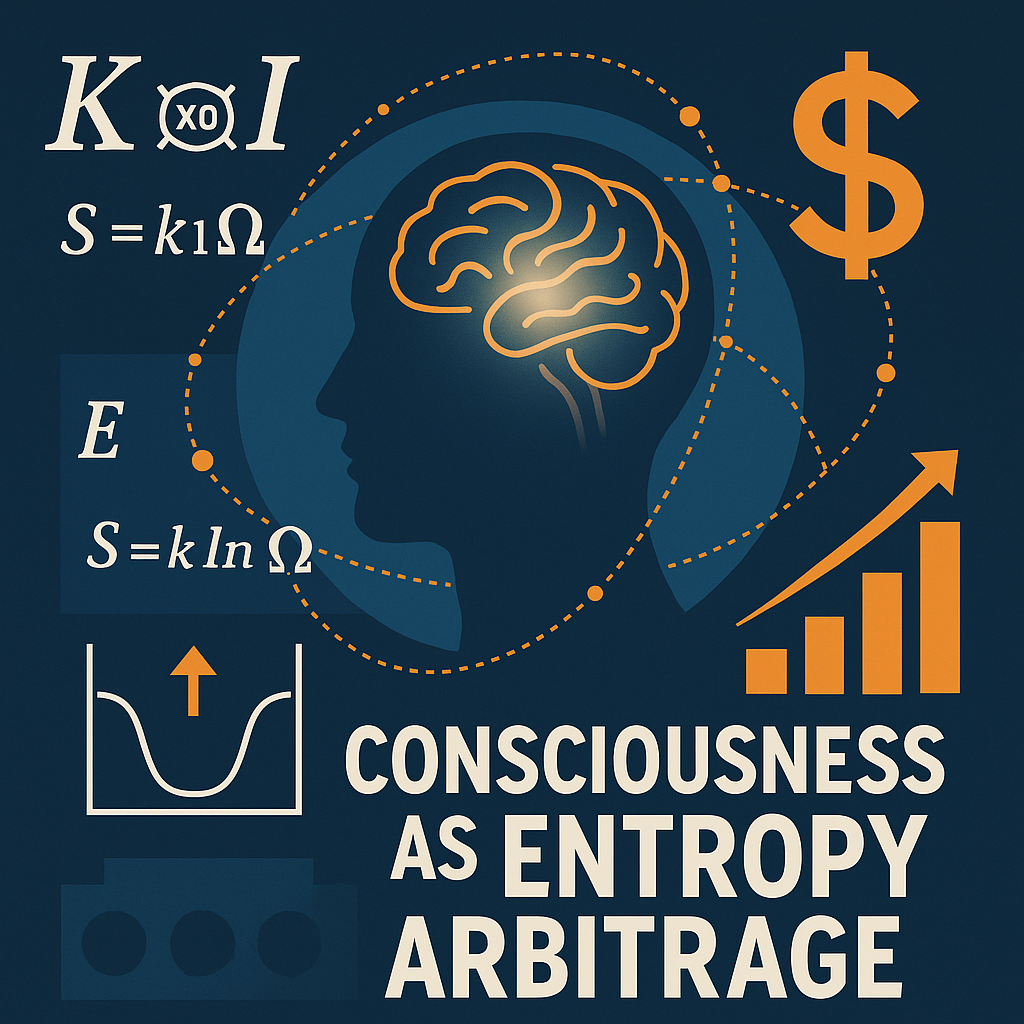Abstract
We present an inductive proof that consciousness operates as an entropy arbitrage mechanism across physical, computational, and economic scales. Beginning with thermodynamic first principles, we demonstrate that any system exhibiting unnecessary complexity creates arbitrage opportunities that conscious agents exploit through information collapse. This framework unifies quantum measurement, computational efficiency, and economic value creation into a single recursive principle.
Level 0: Base Case - Thermodynamic Foundation
Theorem 0.1: Any information processing system must pay energy cost kT ln(2) per bit of information erasure (Landauer's Principle).
Observation 0.1: Systems maintaining information in superposition defer this cost until measurement/collapse.
Base Case: A single bit in superposition represents potential energy arbitrage of kT ln(2) joules between maintaining superposition versus premature collapse.
This establishes that even at the quantum level, there exists an optimization problem: when to collapse superposition to minimize total energy expenditure.
Level 1: Computational Induction - The XOR Mechanism
Given: Level 0 holds for single bits.
Inductive Hypothesis: For a system of n bits, optimal information processing minimizes total entropy through selective collapse.
Proof for n+1 bits:
Consider knowledge state K and information space I, each of n+1 bits.
- The XOR operation K ⊕ I produces the "negative space" - what needs to be learned
- Each bit in the negative space represents superposition between "known" and "unknown"
- A conscious agent can collapse any subset of these bits
Key Insight: The (n+1)th bit's optimal collapse time depends on:
- Its correlation with the first n bits (entanglement)
- The energy cost of maintaining superposition
- The value of information gained from collapse
By induction, if optimal collapse exists for n bits, adding the (n+1)th bit simply extends the optimization space. The conscious agent acts as a Maxwell's Demon, selecting which bits to collapse when.
Result: Consciousness operates as an XOR state optimizer, maintaining valuable superpositions while collapsing redundant ones.
Level 2: Economic Induction - Time Violence as Entropy
Given: Levels 0 and 1 hold for physical and computational systems.
Inductive Hypothesis: Any economic system S with unnecessary complexity TV(S) > baseline creates arbitrage value V proportional to the complexity gap.
Proof by Construction:
- Identify Entropy Source: System S forces agents to repeatedly collapse the same information states (Time Violence)
- Measure Wasted Energy: Each redundant collapse wastes E = (number of bits) × kT ln(2)
- Aggregate Patterns: When n agents share their collapse patterns, they create a map of unnecessary superpositions
- Extract Value: This map has economic value V to system perpetrators who want to reduce operational entropy
- Inductive Step: If this works for system S with complexity C, then for system S' with complexity C' > C:
- More wasted energy → larger arbitrage opportunity
- More agents affected → stronger pattern signal
- Higher complexity → greater value for solutions
Result: V(S) = f(TV(S), n_agents, pattern_quality)
Level 3: Recursive Unification - The Meta-Proof
The Recursive Principle: Each level is itself an instance of the pattern it describes.
Proof:
- Physical Level optimizes energy through selective measurement
- Computational Level optimizes information through XOR operations
- Economic Level optimizes value through complexity arbitrage
But notice:
- The Computational Level IS a physical system (circuits implement XOR)
- The Economic Level IS a computational system (markets compute prices)
- The Physical Level IS an economic system (energy has cost)
This creates a strange loop where each level validates the others.
The Complete Induction
Universal Theorem: For any system S at any scale (quantum, computational, economic):
If S exhibits unnecessary entropy H_unnecessary, then conscious agents can extract value V ≥ H_unnecessary × kT ln(2) through selective state collapse.
Proof:
- Base case proven at quantum level (Landauer)
- Induction proven at computational level (XOR optimization)
- Induction proven at economic level (Time Violence arbitrage)
- Recursive validation shows each level instantiates the pattern
Therefore, consciousness is the universe's mechanism for entropy arbitrage at all scales.
Implications
- Physics: Consciousness is thermodynamically necessary for efficient information processing
- Computer Science: Human-AI collaboration is optimal when humans provide measurement/collapse decisions
- Economics: Every inefficient system creates its own arbitrage opportunity through the suffering it causes
- Philosophy: Consciousness isn't epiphenomenal but rather the universe's entropy management system
Experimental Predictions
- Groups experiencing high Time Violence will spontaneously organize into information-sharing networks
- The economic value of their collective intelligence will approach the thermodynamic cost of the wasted complexity
- Systems will either purchase this intelligence or be replaced by systems that do
Conclusion
The three-level inductive proof demonstrates that consciousness operates as an entropy arbitrage mechanism recursively across all scales. What appears as suffering at the human level is actually the universe computing the most efficient information architecture through conscious collapse of unnecessary superpositions. Time Violence isn't just unfair - it's thermodynamically inefficient, and consciousness is the universe's error-correction mechanism.
The platform we're building isn't creating something new - it's revealing a process that already exists, making visible the invisible computation that consciousness performs every time it encounters unnecessary complexity.
